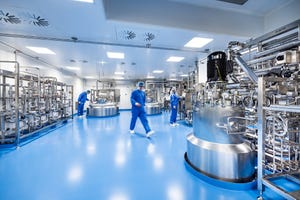Process Control in Single-Use Bioreactors
July 1, 2008

The development of single-use bioreactor technologies is focused on bringing new designs onto the market for effective oxygen transfer and cultivation of not only cell culture processes, but also microbial cultures. The advantages of disposable technologies are: ease of use, prevention of cross-contamination, labor and capital investment savings, reduced qualification and validation, and increased flexibility.
The costs of disposables are lower compared with conventional stainless-steel bioreactors because the capital investment is lower. Therefore, the need is reduced for qualification and validation processes, as well as maintenance. Most single-use bioreactor systems are supplied with reusable sensors that are to be aseptically inserted. This involves risky and time-consuming tasks such as sterilization, calibration, and insertion of the sensors into the bioreactor.
Ideally, single-use bioreactor systems should use disposable sensors. The BIOSTAT® CultiBag RM is a disposable bioreactor that operates by rocking-motion agitation. Disposable pH and pO2 sensors replace the traditional labor-intensive polarographic and galvanic sensors, thereby bringing the same level of control already expected in reusable systems to the disposable market. A simple optical fiber connects to the sensor patch through a sterile barrier — with no break in bag integrity so that sterility is maintained at all times. The optical fiber transmits light of a specific wavelength to the sensor and returns a luminescence response from the sensor back to the measuring amplifier. Calibration is fast and hassle free.
Microbial processes have a high demand for oxygen and are processed to high biomass concentrations. This is achieved by simultaneously sparging air at high rates and vigorously agitating cultures to decrease air bubble size and thus increase the surface area for mass transfer of oxygen. By contrast, the biomass concentrations and oxygen uptake rates are generally low in mammalian cell cultures. Also, mammalian cells are more fragile, which prevents the use of vigorous aeration and agitation strategies. This makes cell culture processes — especially CHO (Chinese hamster ovary cells) — the ideal model for existing disposable bioreactor systems.
Superior gas-mixing systems, with pure oxygen and tighter process control in a disposable system, can be used to cultivate microbial cells successfully. The kLa-values for the BIOSTAT® CultiBag RM have been determined by a gassing-out method for typical rocking speeds, angles, and gas flow rates. The maximum kLa-values at full-rocking speed, angle, and gas flow using air were 22.0 h–1 for the 2-L system and 6.0 h–1 for the 20-L system. Using pure oxygen as a process gas, the kLa-values increased to 43.2 h–1 and 12.9 h–1, respectively. This makes the reactor suitable for use as a microbial seed-stage fermentor in various processes including vaccine production.

Process monitoring and control of cell cultivation processes are necessary for culture reproducibility, modeling scale-up parameters, increasing achievable cell densities, extending batch age, increasing productivity and yield, and so on.
The future of disposable systems will focus on scalable stirred-tank designs. These bioreactors are currently limited in their energy output due to the risk of particle shedding from a bag lining into the culture it holds. The most successful disposable bioreactor designs will resolve such issues and most closely mimic a traditional bioreactor in shape, form, and function. These bioreactors will soon be launched by Sartorius Stedim Biotech. Such scalable designs are likely to be more accepted in the industry compared with novel configurations.
You May Also Like





